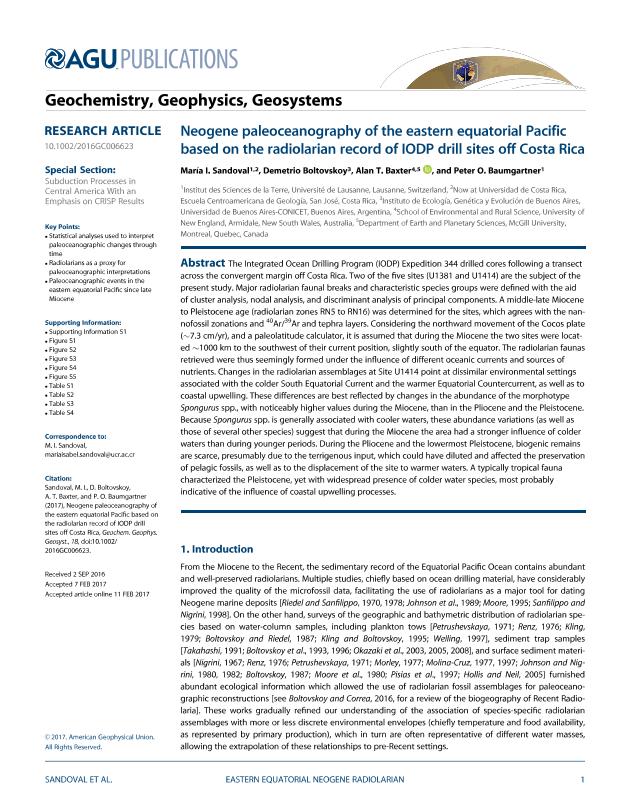Mostrar el registro sencillo del ítem
dc.contributor.author
Sandoval, María I.
dc.contributor.author
Boltovskoy, Demetrio

dc.contributor.author
Baxter, Alan T.
dc.contributor.author
Baumgartner, Peter O.
dc.date.available
2020-02-20T21:58:29Z
dc.date.issued
2017-03
dc.identifier.citation
Sandoval, María I.; Boltovskoy, Demetrio; Baxter, Alan T.; Baumgartner, Peter O.; Neogene paleoceanography of the eastern equatorial Pacific based on the radiolarian record of IODP drill sites off Costa Rica; American Geophysical Union; Geochemistry Geophysics Geosystems; 18; 3; 3-2017; 889-906
dc.identifier.issn
1525-2027
dc.identifier.uri
http://hdl.handle.net/11336/98219
dc.description.abstract
The Integrated Ocean Drilling Program (IODP) Expedition 344 drilled cores following a transect across the convergent margin off Costa Rica. Two of the five sites (U1381 and U1414) are the subject of the present study. Major radiolarian faunal breaks and characteristic species groups were defined with the aid of cluster analysis, nodal analysis, and discriminant analysis of principal components. A middle-late Miocene to Pleistocene age (radiolarian zones RN5 to RN16) was determined for the sites, which agrees with the nannofossil zonations and 40Ar/39Ar and tephra layers. Considering the northward movement of the Cocos plate (∼7.3 cm/yr), and a paleolatitude calculator, it is assumed that during the Miocene the two sites were located ∼1000 km to the southwest of their current position, slightly south of the equator. The radiolarian faunas retrieved were thus seemingly formed under the influence of different oceanic currents and sources of nutrients. Changes in the radiolarian assemblages at Site U1414 point at dissimilar environmental settings associated with the colder South Equatorial Current and the warmer Equatorial Countercurrent, as well as to coastal upwelling. These differences are best reflected by changes in the abundance of the morphotype Spongurus spp., with noticeably higher values during the Miocene, than in the Pliocene and the Pleistocene. Because Spongurus spp. is generally associated with cooler waters, these abundance variations (as well as those of several other species) suggest that during the Miocene the area had a stronger influence of colder waters than during younger periods. During the Pliocene and the lowermost Pleistocene, biogenic remains are scarce, presumably due to the terrigenous input, which could have diluted and affected the preservation of pelagic fossils, as well as to the displacement of the site to warmer waters. A typically tropical fauna characterized the Pleistocene, yet with widespread presence of colder water species, most probably indicative of the influence of coastal upwelling processes.
dc.format
application/pdf
dc.language.iso
eng
dc.publisher
American Geophysical Union

dc.rights
info:eu-repo/semantics/openAccess
dc.rights.uri
https://creativecommons.org/licenses/by-nc-sa/2.5/ar/
dc.subject
CENOZOIC
dc.subject
COSTA RICA
dc.subject
CRISP II
dc.subject
CURRENTS
dc.subject
PALEOCEANOGRAPHY
dc.subject
RADIOLARIA
dc.subject.classification
Paleontología

dc.subject.classification
Ciencias de la Tierra y relacionadas con el Medio Ambiente

dc.subject.classification
CIENCIAS NATURALES Y EXACTAS

dc.title
Neogene paleoceanography of the eastern equatorial Pacific based on the radiolarian record of IODP drill sites off Costa Rica
dc.type
info:eu-repo/semantics/article
dc.type
info:ar-repo/semantics/artículo
dc.type
info:eu-repo/semantics/publishedVersion
dc.date.updated
2019-12-27T14:00:27Z
dc.journal.volume
18
dc.journal.number
3
dc.journal.pagination
889-906
dc.journal.pais
Estados Unidos

dc.description.fil
Fil: Sandoval, María I.. Universidad de Costa Rica; Costa Rica. Universite de Lausanne; Suiza
dc.description.fil
Fil: Boltovskoy, Demetrio. Consejo Nacional de Investigaciones Científicas y Técnicas. Oficina de Coordinación Administrativa Ciudad Universitaria. Instituto de Ecología, Genética y Evolución de Buenos Aires. Universidad de Buenos Aires. Facultad de Ciencias Exactas y Naturales. Instituto de Ecología, Genética y Evolución de Buenos Aires; Argentina
dc.description.fil
Fil: Baxter, Alan T.. University of New England; Australia. McGill University; Canadá
dc.description.fil
Fil: Baumgartner, Peter O.. Universite de Lausanne; Suiza
dc.journal.title
Geochemistry Geophysics Geosystems

dc.relation.alternativeid
info:eu-repo/semantics/altIdentifier/doi/http://dx.doi.org/10.1002/2016GC006623
dc.relation.alternativeid
info:eu-repo/semantics/altIdentifier/url/https://agupubs.onlinelibrary.wiley.com/doi/full/10.1002/2016GC006623
Archivos asociados
